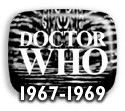The War Games
12 August 2009Well, I succeeded in doing a cover without using the War Room map as a framework. Part of the reason I was against doing so - apart from the fact that most 'War Games' covers, including Clayton's official one, use it - was that I wasn't keen on having lots of panels that I'd need to fill with different elements from the story, unusure that I'd be able to find suitable pictures to represent the various wars featured. It was perhaps ironic, then, that in the end I decided, for a story called 'The War Games', I really did need to include some suggestion of people fighting, and that just showing the villains wouldn't really sell that title. So I ended up with a panelled design after all and faced the task of finding images to fill them.
My breakthrough for getting this to work, however, was the inspiration to use strands of barbed wire to separate the elements. I dare say I'm not the first one to ever do this with a 'War Games' cover, but I figured it was a nice tie-in to the First World War - the prime conflict in the story - and would look eyecatching. In the execution, however, I was reminded that you can't cut corners if you really want to do a good job. I found a few samples of barbed wire, one of which was a clear photo with nice detail, another being darker with some detail but almost a silhouette. Both had the wire strands on a white background, but this meant the former image would be hard to use as the white highlights on the wire bled into the background, making isolating the strands a long-winded painting process. So I chose to use the other image as I could simply set the property of the wire layer to 'multiply' such that the white would become transparent and the almost totally black wire would be effectively isolated. I arranged my strands of wire thus, filled in the areas between with images - and then decided that the wire just didn't stand out enough, being so dark against often dark backgrounds. I tried adding false highlights using layer effects to lift it, but they just looked like what they were, and I quickly realised I would have to bite the bullet and spend some time masking out the more detailed barbed wire photo from its background. It was a little tedious, as I had four strands of wire to give some variety, but worth it in the end. The more three-dimensional image, with clear highlights and shadows, works much better in the final composition and effectively sits above the background elements.
As for those panel fillers, the War Lord and War Chief were givens for my style of covers, and hooray for the photos unearthed by DWM that include the only known shot of the latter - saved me having to use a screengrab. I also wanted to use the romans and their chariot. Although everyone does, it is one of those rare photos with some movement going on, so is hard to resist. That really had to go at the bottom of the composition and the way I'd arranged the barbed wire meant I needed the horses on the right and foot soldiers on the left. They're the other way round in the original photo and I could have simply flipped it, but I thought it would look odd wit the soldiers wielding their swords in their left hands, so I overlaid two copies and used layer masks to position the chariot to the right of the soldiers.
The Roman Zone is visited rather briefly in the story, however, so I didn't want this to be the sole representation of war on my cover (as it pretty much is on the official cover, random explosion nothwithstanding). A web search for 'no man's land' produced photos from the First World War, predictably enough given photography was well developed by then, but I was concerned the only images I'd find of the American War of Independence would be paintings and drawings. However, I did come a cross a cache of photos taken around Republican towns and camps, and while there were none of actual fighting, I managed to find one of a group of drummers who looked as if they were at least preparing to march into battle. I decided I'd pushed my luck enough, though, so for the final, top panel I used a shot of the Alien's War Room rather than try to represent another War Zone. These photos were black and white, of course, but I didn't want to give them just a simple colour wash. So I overlaid a layer with some very roughly filled in colours - nowhere near as carefully done as when I was colouring the photo of the Doctor - then put the flat colour layer over this at around a 60% opacity, so some hint of 'real' colour showed through. For the wash I originally planned a suitably muddly brown, but then thought this might be a bit too close to the colouring of my 'The Invasion' cover, only a couple of cases apart, so shifted it towards khaki.
Finally - although it was the first element I tackled - I had to choose a photo of the Doctor. It seems in nearly all the shots of him from this story he has his face pointed downwards - mainly the ones of him, Zoe and Jamie hunkered down in a crater (as on the official cover, with it's not-quite-successful attempt to reposition the Doctor's eyes so he's looking directly at you) or the Doctor playing cards in his Time Lord cell - or he's in profile, which I generally try to avoid. Or, as I went with in the end, there's that oft-seen shot of him at the TARDIS console, which I decided, despite his downward eyeline again, had a suitably 'this is the end' feel to it.
Download the final WAR GAMES cover here







